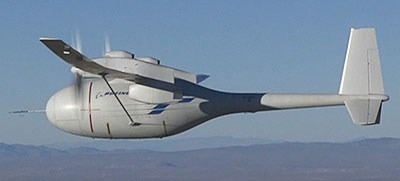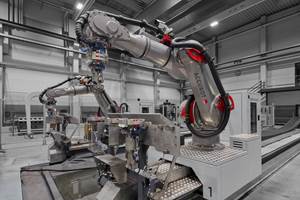UAVs may deliver Internet access
Facebook is considering use of unmanned aerial vehicles (UAV) to bring Internet access to remote areas. The composites industry could be among the beneficiaries.

Unmanned aerial vehicles (UAV) like Boeing's HALE, could be a source of Internet access for remote areas. Increased UAV use means increased composites use.
CNN.com reported on March 28, in a story by Heather Kelly () that two-thirds of the world population does not have Internet access. Facebook already has more than a billion users on its service, but before it can sign up the rest of world it needs to get them online. The social media company announced a new step in its ambitious plan to bring affordable, basic Internet access to "every person in the world." Facebook's new , part of a major tech coalition formed in 2013 (), will research and test experimental technology including drones, satellites and lasers to spread the reach of the Internet to isolated locations that currently do not have Internet.
"We've been working on ways to beam Internet to people from the sky," said CEO Mark Zuckerberg in a post announcing the new effort. Internet.org has already reportedly been responsible for getting 3 million more people online, according to Zuckerberg.
The group is working with drones that can stay in the air for months at a time, bringing Internet connections to suburban areas. In more rural spots, satellites will be tested as a way to beam connections to the people on the ground. The group will attempt to make speedier long distance connections using invisible infrared laser beams. Facebook has brought on aerospace experts from NASA and the team who built the Zephyr solar-powered drone (see a related story about Zephyr on ÂÌñÏ×ÆÞ, www.compositesworld.com/news/solar-powered-zephyr-uas-lands-following-record-flight).
Internet access is a cause major technology companies can easily get behind. It's a smart business investment that doubles as an altruistic charitable cause. Google announced plans to tackle the issue last summer with its own ambitious . Instead of drones, the company is testing giant balloons that travel in the earth's stratosphere for 100 days at a time. Using specialized antennas, the balloons will deliver Internet at 3G speeds.
The CNN article points out that poverty is a more pressing concern than Internet connectivity. However, humanitarian organizations have been pushing for more access in these remote areas to improve the efficiency of aid work. For example, it would make it easier to set up remote health care stations in situations where the nearest doctors or hospitals are hours or days away. And, says CNN, unfettered Internet access allows for freedom of speech and expression. So much so that the United Nations declared access to the Internet a basic human right in 2011. Governments can still censor or filter access to control what information is disseminated, as the Turkish government is doing with its recent attempts to block Twitter and YouTube.
For now, the Connectivity Lab is focusing on the technical challenges of delivering the Internet to geographically tricky spots. Eventually, low-cost Internet and cell phone use could spread to the populations in these areas.
On the same day, Michael Toscano, president and CEO of the Association for Unmanned Vehicle Systems International (AUVSI, Arlington, Va., USA), released the following statement on Facebook’s plans: “It’s exciting to see more and more companies, from retailers like Amazon to technology giants like Facebook, continue to realize the potential of unmanned aircraft systems. The increased attention our industry is receiving demonstrates the wide range of applications of UAS technology. Whether it is delivering packages, surveying farms or providing internet access, UAS can help businesses by saving time, saving money and, most importantly, saving lives. We’re excited to see a growing number of companies investing in the technology and developing innovative uses that will help to change industries and improve lives.”
More drones means more composite material usage, since virtually every design uses very lightweight materials, so growth in this arena is a win for our industry. But, drones still face formidable hurdles before widespread use can occur: integration of drones into regulated airspace is in its infancy, and better proximity systems are needed to prevent collisions between drones and manned aircraft. And, privacy advocates are concerned about the use of data collected by drones, fearing loss of civil liberties. The U.S. FAA has announced a “road map” of steps to integrate unmanned aircraft into the U.S. airspace by September 2015 — if that can happen, drones will be on their way to a greater role in non-military applications.
Related Content
Industrializing additive manufacturing in the defense/aerospace sector
GA-ASI demonstrates a path forward for the use of additive technologies for composite tooling, flight-qualified parts.
Read MoreDevelopment of a composite liquid hydrogen tank for commercial aircraft
Netherlands consortium advances cryogenic composites testing, tank designs and manufacturing including AFP, hybrid winding, welding of tank components and integrated SHM and H2 sensors for demonstrators in 2025.
Read MorePlant tour: Airbus, Illescas, Spain
Airbus’ Illescas facility, featuring highly automated composites processes for the A350 lower wing cover and one-piece Section 19 fuselage barrels, works toward production ramp-ups and next-generation aircraft.
Read MoreAutomated robotic NDT enhances capabilities for composites
Kineco Kaman Composites India uses a bespoke Fill Accubot ultrasonic testing system to boost inspection efficiency and productivity.
Read MoreRead Next
Cutting 100 pounds, certification time for the X-59 nose cone
Swift Engineering used HyperX software to remove 100 pounds from 38-foot graphite/epoxy cored nose cone for X-59 supersonic aircraft.
Read MoreScaling up, optimizing the flax fiber composite camper
Greenlander’s Sherpa RV cab, which is largely constructed from flax fiber/bio-epoxy sandwich panels, nears commercial production readiness and next-generation scale-up.
Read MoreNext-gen fan blades: Hybrid twin RTM, printed sensors, laser shock disassembly
MORPHO project demonstrates blade with 20% faster RTM cure cycle, uses AI-based monitoring for improved maintenance/life cycle management and proves laser shock disassembly for recycling.
Read More












